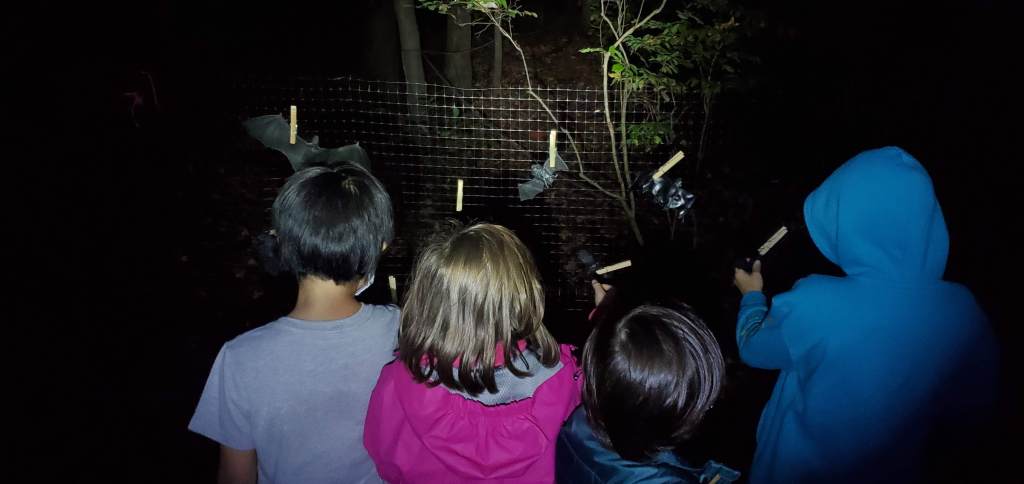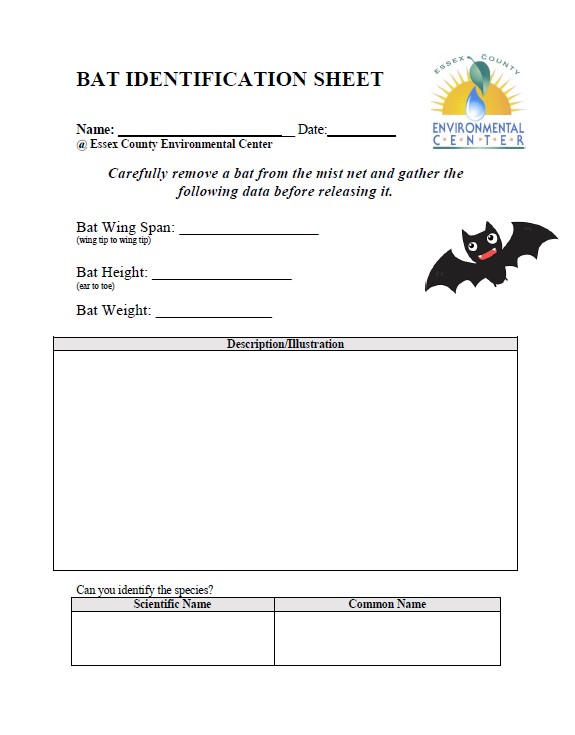
It’s always a good time to champion bats but this happens to be National Bat Week and just before Halloween so a good time to engage curiosity through involvement in a simulated bat scientific study where they collect data just as the biologists would in the field.
Participants label the anatomy of a bat, play a bat and moth game and discuss bat shelters before they begin the study. For the simulated study, I hang up a few varied size plastic toy bats in a net for the students to find, weigh and measure. They illustrate the bat and record any identifying features to determine what species it could be. One of the bats will have white paint on it’s nose to represent white nose syndrome. This will help add to our conversation about bat conservation concerns and what we can do to help support their populations.
Echolocation: the location of objects by reflected sound, in particular that used by animals such as dolphins and bats.
Play Bat & Moth!
- Choose one person to be a bat and one to be the moth. They wear a blindfold.
- Everyone else is the forest and holds hands up to protect players within a circle.
- The person who is a bat stands in the center and calls out “bat” When the bat calls, the moth replies “moth.”
- The bat has to try to catch the moth, and the moth should “fly” away from the bat.
- The bat continually calls out “bat” and the moth replies “moth.” until caught.
- Participants take turns to be the bat and moth.
Participants can also wear a blindfold and gently throw a ball against a wall and try to listen for the sound as the ball bounces back and then try to catch it. Participants may need to try without the blindfold first to practice the coordination and progress to the blindfold.
BAT FACTS (you can put these in a paper bag and let the students pull one out to read it aloud)
- Bats are the only flying mammals
- Bats are nocturnal; they are most active at night
- Bats sleep during the day hanging upside-down
- Some bats use echolocation to find insects and small animals to eat
- Some bats use their sense of smell to find their food, fruit and/or nectar
- There are over 900 different species of bats
- New Jersey is home to 9 different species of bat.
- The vampire bar is the only bat that drinks blood
- A single bat can consume up to 3,000 mosquito-sized insects in one night!
- Their value to agriculture is estimated at $53 billion annually in the United States alone.
- Bat poop is called as Guano. Guano is a highly effective fertilizer due to its exceptionally high content of nitrogen, phosphate and potassium: nutrients essential for plant growth.
HOW TO IDENTIFY NEW JERSEY BATS
This key assumes you have a bat specimen to observe and have been trained in capture techniques and have had a rabies vaccine. Start at choice #1…pick the choice that fits the bat’s characteristics. Go to the number of the next choice indicated.
Keep making choices until you end at the name of the bat.
- Tail membrane (TM) dorsal surface part or totally furred….go to 2.
- Dorsal TM unfurred…….go to 4
- TM dorsal surface furred on bottom half only……Silver-haired bat
- TM completely furred…….go to 3
- Dorsal fur multicolored yellowish and dark grey; ears light with dark edges…Hoary bat
- Dorsal fur in males – reddish-orange; ears without dark edge…Red bat
- Dorsal fur tri-colored; reddish-orange dorsal forearm lighter color than wing membrance……Eastern Pipistrel
- Dorsal fur bi-colored; dorsal forearm surface same color as wing membrance…go to 5
- Forearm 4.4 cm or larger……Big Brown Bat
- Forearm 4.1cm or smaller……go to 6
- Distinctive black face mask present……….Eastern small-fotted bat
- No distinctive black face mask…go to 7
- Ears 17-19 mm (4mm past nose when laid forward)….Northern long-eared bat
7. Ears 16mm long or less…..go to 8
- Calcar keeled; only short hairs on toes….Indiana Bat
8. Calcar not keeled; toe hairs extending to tips of claw or beyond…..Little Brown Bat
Adapted from Bat Conservation International by Friends of Great Swamp
To learn more about bat conservation in New Jersey visit the NJ Conserve Wildlife Foundation.
David Alexander is author of the Buzz Into Action & Hop Into Action Science Curricula. He specializes in making nature accessible to people and wildlife. You can follow him at www.natureintoaction.com













Outstanding work from one of the best environmentalists in the world. Bravo David.
[…] TOPICS: All About Bats, Polypore Mushroom Paper Making, Composting 101, Autumn Olive Fruit Roll-ups, Mushrooms […]
[…] TOPICS: All About Bats, Polypore Mushroom Paper Making, Composting with Worms Lab, Autumn Olive Fruit Roll-ups, Mushrooms […]